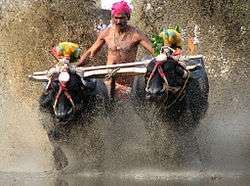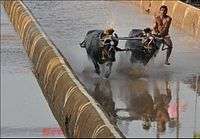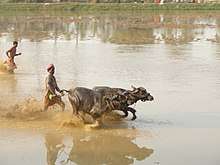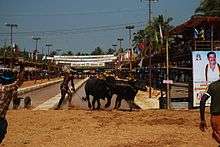Kambala
Kambala is an annual buffalo race held in the southwestern Indian state of Karnataka. Traditionally, it is sponsored by local Tuluva landlords and households in the coastal districts of Dakshina Kannada and Udupi of Karnataka and Kasaragod of Kerala, a region collectively known as Tulu Nadu.


The Kambala season generally starts in November and lasts until March. The Kambalas are organized through Kambala samithis (Kambala Associations), of which there are currently 18. Over 45 races are held annually in coastal Karnataka, including smaller remote villages such as Vandaru and Gulvadi.

Etymology
Kambla as derived from 'kampa-kala ' the word 'Kampa' is related slushy, muddy field. The Dravidian origin of the word Kampa by is kan+pa. And word 'kala' means field, where it happen. In other interpretation in modern Kambla is that 'Kamba', nishane a pole used for water spurt during race by buffalo pairs.[1]
Format

Kambala is traditionally a simple sport which entertains rural people of the area.[2] The Kambala racetrack is a slushy paddy field,[3] and the buffaloes are driven by a whip-lashing farmer.[4]
Traditional Kambala was non-competitive, and the pair was run one by one. In modern Kambala, the contest generally takes place between two pairs of buffaloes. In villages such as Vandaro and Choradi, there is also a ritualistic aspect, as farmers race their buffaloes to give thanks for protecting them from diseases.
Historically, the winning pair of buffaloes was rewarded with coconuts and bananas. Today, winning owners earn gold and silver coins.[5] Some organising committees award an eight-gram gold coin as first prize.[6] In some competitions, cash prizes are awarded.
Decoration of Buffalo
The buffaloes are decorated with coloured jhūls and marvellous head-pieces of brass and silver (sometimes bearing the emblems of the sun and moon), and ropes which make a sort of bridle. The special towel used to cover the buffalo's back is called the paavade(Tulu:ಪಾವಡೆ).
Types of Kambalas
Traditionally, there were types of Kambalas
- Pookere Kambala
- Baare Kambla
- Kori Kambala
- Arasu Kambla
- Devere Kambla[7]
- Baale Kambala
Kori Kambla
Kori Kambla is a distinct agriculture-based celebration in Tulunadu. This refers to a kind of collective ploughing and planting on a fixed day for the enelu(Tulu: ಏಣೆಲ್) cultivation. A general race of buffaloes is known as kori (kandoe korune)[1] Kambala. It highlights the principle of cooperation in cultivation which, in turn, helped in moulding the community life of the people of Tulunadu.
Bale Kambla
The celebration of Bale Kambala was discontinued about 900 years ago. Bale means baby, looks like small kambla, the small formers prepares their field for paddy cultivation.
Natha Pantha
The kambla influenced by Natha pantha[8], in earlier days, the Kambla starts previous day evening with tradition dance of Koraga communities mostly by men. They performing full night with following all panchakarma madya (Alcohol), māṃsa (Meat), matsya (Fish), mudrā (Gesture), maithuna (Sexual). The Koragas were sit up through the night before the Kambla day, performing a ceremony called panikkuluni, the meaning of word sitting under the dew. They sing songs to the accompaniment of the their special kind of band dudi, about their special spirit daiva Nīcha, and offer toddy and a rice-pudding boiled in a large earthen pot, which is broken so that the pudding remains as a solid mass. This pudding is called kandēl addyē, or pot pudding.[9]
Innovations
Kambala has become an organised rural sport, with elaborate planning and scheduling to accommodate competietions at different places.[10] A "Kambala Committee" arranges races in several categories describing the outfitting of the buffaloes. Typical categories are:
- Nāyer(ನಾಯೆರ್): The runner have hold kind of special plough, it is not actual plough which is heavy and bulky made by wood or iron , it is just a representation of which is tied to pair of buffalo. This type is mostly for the Junior buffaloes or entry level buffaloes. In the competetion junior, senior rounds in this race.
- Bal (ಹಗ್ಗ: rope), A rope is directly tied to the buffalo pair. And this is for Senior buffaloes as the speed is more here and the participating buffaloes are well experienced. Runner running aside of baffelo holding knots in the rope. This has a Junior, senior levels.
- Aḍḍa palāyi (ಅಡ್ಡ ಪಲಾಯಿ: cross wooden block),A cross wooden plank is tied to the pair and the runner stands on it while racing. The wooden plank horizontaly placed to muddy water, the runner stands on the plank. This is just for the senior category.[11]
- Kaṇe palāyi (ಕಣೆ ಪಲಾಯಿ: round wooden block), A special made round wooden block where the runner stands on it on his single leg. There will special techniques with two holes in the block of wooden, which act like orifice, out of which the water forces out while running. The height of the water forcing out is measured to choose the winner. The more the speed is more the water height is. It would be 6 kolu or 7 Kolu there will a horizontal white cotton flag is installed so the general people judge the winner y eye witness. Commonly it is called Nishaneg Neer Padune And this is only for senior most category.[12]
Kambala draws large rural crowds, as it has done for the last three hundred years.[13] People bet on the buffaloes, and one can witness more than 20,000 spectators in a well-organised Kambala, egging on and cheering the buffaloes to complete the race.
In some places, night races are arranged under floodlights.[6]
The buffaloes developed for the race are carefully fed and some owners have even built separate swimming pools for competing buffaloes.[14]
Kadri Kambala
Kadri Kambala used to be held at Kadri, Mangalore and it is called Dēvere Kambla (God's Kambala) as it is associated with Sri Manjunatha Temple in that city.[10] This event was patronised by the Alupa kings of Mangalore, 300 years ago. For this reason, Kadri Kambala is also known as Arasu Kambala (King's Kambala).[10]
Legal status
Animal lovers have criticised Kambala as cruel to the racing buffaloes, which are driven by whips.[15] Noted animal-rights activist Maneka Gandhi expressed concerns about the ill treatment of buffaloes during the race. Kambala organizers contend that whips are necessary to elicit maximum speed. Government officials advise the riders to be gentle on buffaloes and avoid using whips during the race.[15]
In 2014, based on lawsuits filed by animal welfare organizations, the Supreme Court of India ordered a ban on Kambala. The ban also covered Jallikattu, a sport of hands-on bull taming. A government order lifted the ban on Jallikattu in January 2017, and the public asked for the ban on Kambala to be lifted too.[16]
The Prevention of Cruelty to Animals (Karnataka Amendment) Ordinance, 2017[17] re-legalized the Kambala festival in Karnataka.[18] President Pranab Mukherjee promulgated the new law on July 3, 2017. Litigation continued but was resolved by the passage of the Prevention of Cruelty to Animals (Karnataka Amendment) Bill, 2018, which President Ram Nath Kovind approved on February 19, 2018.[19]
Schedule
| Town/Village | Taluk | Date of Kambala | Appx. pairs | Image | Remarks |
|---|---|---|---|---|---|
| Kadri | Mangalore | December |  |
Competitive race / Much famed | |
| Vandaru | Kundapura | December | 300 |  |
Non competitive race |
| Pilikula[5] | Mangalore | December/January | 150[20] |  |
Competitive race |
| Choradi | Kundapura | December | 150 | Non competitive rural sport | |
| Gulvadi | Kundapura | December | 200 | Non competitive rural sport | |
| Baradi beedu | Karkala | December | Competitive race | ||
| Venur Permuda | Belthangadi | December | |||
| Moodabidri | Mangalore | December | Competitive race | ||
| Miyar | Karkala | January | Lava Kusa Jodukere Kambala. | ||
| Katapadi beedu | Udupi | January | Competitive race | ||
| Aikala Bava | Mangalore | February | Competitive race | ||
| Adve, Nandikur | Udupi | January | Competitive race | ||
| Pajir | Bantwala | February | |||
| Yeedu | Karkala | February | |||
| Puttur | Puttur | March | |||
| Jappina Mogaru[6] | Mangalore | March[6] | 150[6] | ||
| Uppinangadi | Puttur | March | |||
| Bangadi Kolli | Belthangadi | March | |||
| Thalapady Panjala | Mangalore | March/April | |||
| Althar | Udupi | March/April | |||
| Parika Aramane | Udupi | November/December | |||
| Hokkadi goli | Bantwala | December | |||
| Handadi | Udupi | December | |||
| Vaddambettu[21] | Udupi | December[21] | |||
| Ajri[22] | Udupi | December | |||
| Mulki seeme | Mangalore | December | Competitive race |
See also
- Pacu jawi, a similar type of race held in Tanah Datar, West Sumatra, Indonesia.
- Flying duck race (pacu itiak) in Payakumbuh, another area in West Sumatra
- Karapan sapi, chariot-style bull racing from Madura, Indonesia
References
- TuLunadina ShasanagaLa Sanskritika Adhyayana. By Shaila T. Verma (2002) Jnanodaya Prakashana,Bangalore, p.304.
- Chaudhari, edited by Sarit K. Chaudhari, Sucheta Sen (2005). Primitive tribes in contemporary India : concept, ethnography and demography. New Delhi: Mittal Publications. p. 120. ISBN 9788183240260.CS1 maint: extra text: authors list (link)
- "Kadri comes alive with 'Kambala', fair". The Hindu. 13 December 2010. Retrieved 7 December 2012.
- Herzberg, Esther Grisham,Christine Ronan,editor-Roberta Dempsey (1997). South India (sb ed.). Glenview, IL: Good Year Books. p. 5. ISBN 9780673363596.
- "Kambala". The Hindu. 26 December 2011. Retrieved 7 December 2012.
- "Day and night kambala in Jeppinamogaru on March 19". The Hindu. 16 March 2011. Retrieved 7 December 2012.
- https:Kambala:A sport and a tradition, Feb 7, 2017, www.deccanherald.com/content/595115/kambala-sport-tradition.html
- Tuluvara mooltāna Adi Alade Paramrapare mattu Parivartane by Dr. Indira Hegde, [Navakaranataka,Bangalore,2012,p.278]
- Karavali Janapada 1990, Mangalagangothri by Dr. Purushothama Bilimale, p.36
- "All set for Kambala season from tomorrow". The Hindu. 5 December 2009. Retrieved 23 February 2018.
- KAMBALA: THE RACE OF THE BUFFALOES, http://www.dineshmaneer.com/kambala-the-race-of-the-buffaloes/
- Dinesh Maneer (7 April 2011). "Kambala, the race of the buffaloes". Wordpress. Retrieved 23 February 2018.
- "Kadri Kambala witnesses confluence of Tulu culture". Deccan Herald. 2 December 2012. Retrieved 7 December 2012.
- "Chill-out zone for buffaloes". The Hindu. 18 September 2012. Retrieved 7 December 2012.
- "Pilikula Nisargadhama plays host to Kambala". The Hindu. 10 January 2012. Retrieved 7 December 2012.
- "Jallikattu Back, Why Not Kambala, Asks Karnataka. Protests Begin". NDTV.com.
- Ravi, Anusha (3 July 2017). "Kambala is now legal in Karnataka, President promulgates ordinance". Oneindia.
- Kumar, Ganesh; Udayakumar, Radha (3 July 2017). "President Mukherjee approves ordinance allowing the conduct of kambala in Karnataka". India Today.
- K.T. Vinobha (19 February 2018). "President approves Bill allowing Kambala in Karnataka". Times of India.
- "Grandeur marks Pilikula Kambala". The Hindu. 22 December 2008. Retrieved 7 December 2012.
- "Federation says Koraga people made to beat drums during kambala". 15 December 2011. Retrieved 7 December 2012.
- "Ajri Kambala". Kundaprabha (weekly). 4 December 2012. Retrieved 7 December 2012.
External links
| Wikimedia Commons has media related to Kambala. |